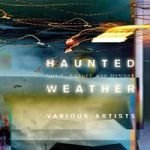
Various Artists (compiled by David Toop) Haunted Weather
(Staubgold)
Some of you may know David Toop from his pioneering and frequently re-edited book The Rap Attack, a history of all things hip-hop that took the unlikely but fruitful step of attempting to write abut rap, DJing, graffiti and b-style in a way that reflected both the sociological significance and the musical vibrancy of hip-hop. As an author he has also worked on the landmark Ocean of Sound, as well as being curator for the magnificent exploration of acoustic art "Sonic Boom" at London's Hayward Gallery. His writing, ever stimulating and impossibly knowledgeable, appears in The Wire, The Times and the soon to be defunct Face.
Now he returns with this project, a book and a double-disc compilation album showcasing the interface between avant-garde instrumentalists and cutting-edge laptopica. The project found its genesis in a small club in Tokyo, at a concert called Noise as Silence. Musicians playing laptop computers and mixing desks were dotted around the audience, connected via a network of sound, while the violinist Tetsuo Furudate and vocalist Yurihito Watanabe improvised to the complex and nebulous music. The interface was an attempt to link human memory with technological advancement, to move forward without losing sight of the past. The concert became emblematic for Toop of the possible relationship between computers and musicians in the modern age, in particular with the question that the capability of computers raises about the necessity of live performance.
Much of this album then explores the crossing point between the environment, the artist and technique. Musicians such as Janet Cardiff, whose recording of urban monologues with audio equipment turn the concepts "live" and "recorded" on their heads, or Alvin Luciers recording of sferics, natural radio frequency emission that exist in the ionosphere, caused by electromagnetic energy from distant lightening. Then there are the more instrumental performances, like Taku Sugimoto's minimal live strings, or the Spontaneous Music Ensemble's attempts to smash up an orchestra. Then there are the moments of pure computer music - Autechre, for one, or pure madness, such as Derek Bailey and John Stephens who sound like they're smashing up a kitchen or John Butcher who appears to be deflating a balloon. At the same time there are intense moments of beauty, like Carston Nicolai and R Sakamoto's duoon, possibly the finest example of the types of interface that Toop is aiming at.
If you like tunes and something that you can follow, steer clear. But if you are interested by some of the most provocative and pressing interactions between individual performers and the resources that exist, both in music and the world around us, Toop's compilation will provide inspiration and excitement.
29 May, 2004 - 23:00 — Ben Bollig